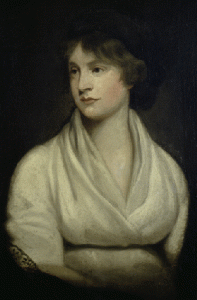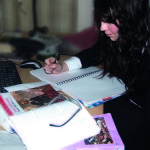Mary Wollstonecraft (1759-1797)
Table of Contents
Writer, feminist and radical; author of A Vindication of the Rights of Woman (1792)
Overview
Mary Wollstonecraft was a passionate Enlightenment thinker who is generally celebrated as the first major feminist. Her most significant text, A Vindication of the Rights of Woman (1792), is a systematically-argued call for women’s independence which is breathtaking in its modernity. Her latest biographer, Lyndall Gordon, argues:
Many of her issues presage the present: women’s need to unfold their faculties…. The problems of communication between the sexes; long-term partnership in place of marriage; economic independence; the freedom to express desires without derision or loss of dignity; and, not least, the problems and triumphs of the single parent in the context of Wollstonecraft’s belief that a child should not be left to the care of strangers.
Although calls for women’s education had been made earlier by female intellectuals such as Bathsua Makin (c1608-1675), Margaret Cavendish (c1623-1674) and Mary Astell (1666-1731), Wollstonecraft’s Vindication provided a first all-embracing framework for modern feminism. But in addition to her writing, Wollstonecraft lived a life in revolt against constraint and sexual prejudice—a revolt which later scandalised nineteenth-century sensibilities. Although admired by many radical contemporaries, for others she was an ‘hyena in petticoats’ (Horace Walpole). In 1801 the Anti-Jacobin Review wrote (1801):
For Mary verily would wear the breeches
God help poor silly men from such usurping b—s.
Biography

Portrait of Mary Wollstonecraf
Mary Wollstonecraft was born in London in 1759 to a fairly prosperous family of merchants (later farmers). Although she was one of seven children, only her brother Ned received an education. Mary was impressively learned, but practically all of it, including several foreign languages, was gained through her own efforts. In the Vindication Mary is passionate about the disparity in women’s and men’s educational opportunities, an anger acquired via personal experience.
Mary’s family did not prosper financially and she was forced to seek employment, something that could be challenging to a middle-class woman’s status. Only a handful of occupations were acceptable for respectable ladies, including becoming a governess, teaching or serving as a ladies’ companion. These occupations were not conducive to Mary’s forthright nature and, in an attempt to gain greater independence, she established a small school in London. When this failed to prosper, Mary turned to writing as a means to earn money.
For a woman to become a writer was not totally new in the eighteenth century; women were becoming common as authors of fiction especially. Mary found support from the new friends she had acquired in London, mostly rational dissenters (later known as Unitarians) who, on the whole, supported equality of opportunity for women. In 1786 Mary published Thoughts on the Education of Daughters (1787) and soon began writing regularly for periodicals.
In 1790 Edmund Burke published an attack on the French Revolution (Reflections on the Revolution in France) which outraged many in progressive-thinking English circles, including Mary who railed against its inhumanity. In response, she produced Vindication of the Rights of Men (1790). This was an immediate success and Mary’s name was bracketed with that of Thomas Paine whose own, much more famous, The Rights of Man, appeared in 1791.
Mary Wollstonecraft and Love
Although Mary spent her life championing independence for women, she herself was prone to falling head over heels in love and her romances frequently made her unhappy.
Mary met the painter and literary figure Henry Fuseli in 1788. Fuseli, forty-seven at the time, is said to have been a small, self-important dandy. He was also married, which did not stop Mary becoming infatuated with him. Fuseli courted Mary’s affections, but showed no intention of leaving his wife, Sophia. The affair ended when Mary suggested a ménage à trois and Sophia, enraged, put a stop to Fuseli’s philandering (with Mary at least).
So, in December 1792, Mary travelled alone to Paris where she hooked up with a group of other radical expats and, the next year, met Captain Gilbert Imlay. Imlay was an American revolutionary soldier turned commercial adventurer— a handsome man accustomed to sexual adventures with women. Mary fell madly in love with him, and by the end of the summer of 1793 she was pregnant.
Meanwhile, the situation in Paris had become dangerous. Imlay, protected by his American nationality while English visitors were being imprisoned, registered Mary as his wife at the American embassy and then left on a business trip, leaving her alone, pregnant and anxious. She followed him, first to Le Havre (where Fanny was born on 14 May 1794) and eventually to London, where she hoped they might establish a family home. When Imlay disappointed her, Mary swallowed what was intended to be a suicidal dose of opium and was saved only when a maidservant revived her. After a few more sorry episodes with Imlay, Mary discovered that he had set up home with someone else, prompting her to throw herself off Putney Bridge into the Thames (this time two passing watermen saved her).
William Godwin (1756–1836) was Mary’s final love. Godwin was author of An Enquiry Concerning Political Justice and, when Mary met him, he was the foremost radical philosopher of his day. At the start of 1797 Mary discovered that she was pregnant and the couple married (despite Godwin’s earlier avowed political objections to the institution). Mary went into labour in the early hours of 30 August and gave birth to Mary Wollstonecraft Godwin (later Mary Shelley, author of Frankenstein) about eighteen hours later. The birth itself was straightforward, but the placenta failed to deliver and was then extracted manually, which led to haemorrhaging and infection. She died of puerperal fever eleven days later. She was buried in St Pancras churchyard on 15 September; in 1851 her remains, along with Godwin’s, were moved to St Peter’s churchyard in Bournemouth. It was Godwin’s biography of his wife, published the year after her death, which brought Mary’s adventurous life into the public sphere and caused her work to be shunned by polite society in the following century.
A Vindication of the Rights of Woman
When Mary wrote A Vindication of the Rights of Woman she was responding to the French Revolution which had initiated intense debate about political rights and citizenship, including the first extensive discussion of women’s emancipation. This ‘feminist’ debate in the late eighteenth and early nineteenth centuries was shaped by changing socio-economic factors.
The expansion of trade and manufacture had brought an increase in the size, wealth and influence of the urban middle class. But although women of this class benefited from increasing family wealth, they did not receive other rights like the men. In England these changes were accompanied by the demise of the traditional idea that families were income-generating units in which all, male or female, played their part. Now, the male was elevated to the position of bread-winner—earning his status as a gentlemen by supporting his wife and daughters in leisure. So the late eighteenth century, in effect, saw the gradual withdrawal of middle-class women from paid labour; instead women moved into domesticity, looking after the home, giving their attention to the family, and making use of a massive increase in consumer goods for the home. This withdrawal of women from paid labour and their involvement in domestic duties was accompanied by extensive discussion of the innate suitability of women for this sphere.
In this context, A Vindication of the Rights of Woman was a controversial best-seller. When the evangelical writer Mrs Hannah More was asked if she had read A Vindication of the Rights of Woman she replied with an emphatic ‘no’, adding ‘There is something fantastic and absurd in the very title’ and that in her view ‘there is no animal so much indebted to subordination for its good behaviour as woman’. Other conservatives agreed and labelled Mary’s book ‘indecent’.
But to modern readers the Vindication can read as a very moralising text, telling-off women for being vain and frivolous and calling for a ‘revolution in female manners’. For example, Mary speaks of how lust can be ‘depravity of the appetite which brings the sexes together’ and goes on to argue that if sex is dignified by parenthood both sexes gain:
Women then having necessarily some duty to fulfil, more noble than to adorn their persons, would not contentedly be the slaves of casual lust; which is now the situation of a very considerable number who are, literally speaking, standing dishes to which every glutton may have access.
(From Chapter VIII: ‘Morality Undermined by Sexual Notions’)
Mary’s other arguments include
- Women’s shortcomings are produced by the ‘unnatural distinctions’ of rank and privilege which distort and injure both women and men. Throughout the book she equates the degradation of women to the debasement of men caught up in a class-ridden society. In this way, Mary argues that it is for the benefit of both sexes, indeed for the whole of humanity, that women should be emancipated, leading to complete equality for both sexes.
- She discusses sexual difference and argues that the construction of femininity, both in theory and in the conduct of everyday life, creates woman in a way that serves the interests of male sexual desire. A properly feminine woman was one designed to suit masculine tastes.
- She demands that women, like men, have the right to be regarded as autonomous, independent beings, entitled to be citizens. She does not deny sexual difference however; rather she sees women as having specific roles in the family and wider society.
- Women and men should be brought up to be equal citizens and argues that education and rationalism would then triumph over custom and prejudice. (This would rehabilitate the socially-useless middle and upper class woman).
The Vindication regained popularity amongst feminists and suffrage campaigners towards the end of the nineteenth century and in 1891 the suffrage leader Millicent Garrett Fawcett endorsed Mary’s thoughts by writing the introduction to the hundredth anniversary edition of the Vindication.
References
The Penguin Classics rev. ed of A Vindication of the Rights of Woman ![]() has a wonderful introduction by Miriam Brody.
has a wonderful introduction by Miriam Brody.
Lyndall Gordon’s Vindication: A Life of Mary Wollstonecraft (Virago, 2005)![]() manages to be a scholarly book which is also a great read.
manages to be a scholarly book which is also a great read.










Please can you tell me where I can locate H Walpole’s quote re Mary Wollenstonecroft ‘hyena in petticoats’?
Can you tell me where I can locate Horace Walpole’s quote re Mary Wollstonecroft ‘hyena in petticoat’ please? Thank you